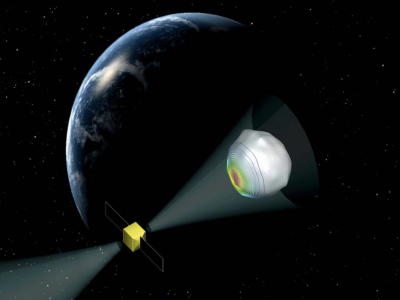Contactless asteroid orbit modification system MOSAIC and bindary asteroid orbit modification KABOOM

KABOOM
We study a low-cost interplanetary mission to demonstrate the capability of artificially modifying the orbit of a small (250 ton) binary asteroid body. The targeting spacecraft survives the slow (~1 m/s) impact to carry out the orbit modification measurement afterwards.
Methodology:
A novel impacting method is employed that makes use of a relatively simple “pogo-stick” elastic appendage allowing to ideally double the transmitted momentum and minimise the residual rotation of the spacecraft after the manoeuvre. First the underlying physical aspects of the concept as well as the main criteria for the selection of the target asteroid to be deflected are analysed. Next, an assessment of a technology demo mission for the deflection of a small secondary asteroidal body using the proposed pogo-stick concept is conducted. This involves the interplanetary trajectory analysis and design, the terminal guidance and navigation for impacting the small asteroid, a preliminary design analysis of the pogo-stick mechanism, and a preliminary system design of the mission. Last, a possible technology readiness roadmap for the development of the proposed concept and the improvement of its performance is outlined.
MOSAIC
We study a low-cost interplanetary mission to demonstrate the capability of modifying the orbit of a small (130 ton) asteroid with contactless momentum transfer. The reduced size of the object allows low-delta-V transfer to existing NEOs and greatly simplifies the deflection phase.
Methodology:
The recently proposed ion beam shepherd (IBS) contactless deflection method is employed, in which the asteroid is deflected by a flux of impinging ions emitted by a state-of-the-art ion thruster. First the underlying physical aspects of the concept as well as the main criteria for the selection of the target asteroid to be deflected are analysed. Next, an assessment of a technology demo mission for the deflection of a small asteroid using the IBS concept is conducted. This involves the interplanetary trajectory analysis and design, the terminal guidance and navigation for rendezvous with the small target, a detailed analysis of the most critical aspects of the IBS concept (i.e. backsputtering contamination) and a preliminary system design of the mission. Last, a possible technology readiness roadmap for the development of the proposed concept and the improvement of its performance is outlined.
